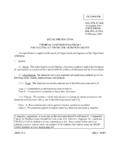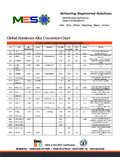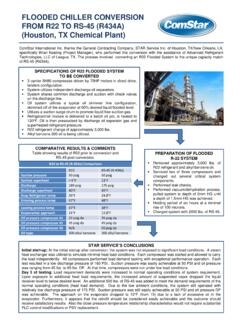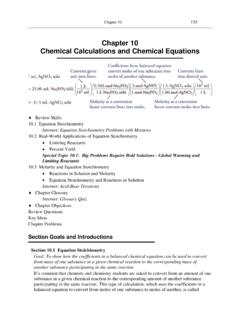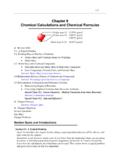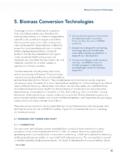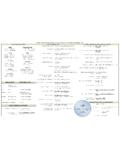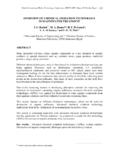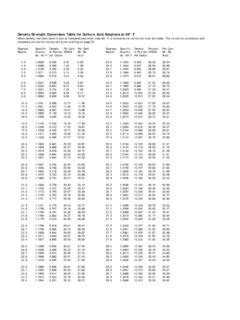Transcription of MIL-DTL-5541F Chemical Conversion Coatings on Aluminum …
1 NOT MEASUREMENT. SENSITIVE. MIL-DTL-5541F . 11 July 2006. SUPERSEDING. MIL-C-5541E. 30 November 1990. DETAIL SPECIFICATION. Chemical Conversion Coatings . ON Aluminum AND Aluminum ALLOYS. This specification is approved for use by all Departments and Agencies of the Department of Defense. 1. SCOPE. Scope. This specification covers Chemical Conversion Coatings formed by the reaction of Chemical Conversion materials with the surfaces of Aluminum and Aluminum alloys. Classification. The Chemical Conversion Coatings are of the following types and classes. Types. The Chemical Conversion Coatings are of the following types (see ): Type I Compositions containing hexavalent chromium. Type II Compositions containing no hexavalent chromium. Classes. The materials, which form protective Coatings by Chemical reaction with Aluminum and Aluminum alloys, are of the following classes (see and ). Class 1A - For maximum protection against corrosion, painted or unpainted.
2 Class 3 - For protection against corrosion where low electrical resistance is required. Comments, suggestions, or questions on this document should be addressed to: Commander, Naval Air Warfare Center Aircraft Division, Code 491000B120-3, Highway 547, Lakehurst, NJ 08733-5100 or emailed to Since contact information can change, you may want to verify the currency of this address information using the ASSIST. Online database at AMSC N/A AREA MFFP. MIL-DTL-5541F . 2. APPLICABLE DOCUMENTS. General. The documents listed in this section are specified in sections 3 or 4 of this specification. This section does not include documents cited in other sections of this specification or recommended for additional information or as examples. While every effort has been made to ensure the completeness of this list, document users are cautioned that they must meet all specified requirements of documents cited in sections 3 or 4 of this specification, whether or not they are listed.
3 Government documents. Specifications and standards. The following specifications and standards form a part of this document to the extent specified herein. Unless otherwise specified, the issues of these documents are those cited in the solicitation or contract. FEDERAL STANDARDS. FED-STD-141 - Paint, Varnish, Lacquer and Related Materials: Methods of Inspection, Sampling and Testing DEPARTMENT OF DEFENSE SPECIFICATIONS. MIL-PRF-23377 - Primer Coatings : Epoxy, High-Solids MIL-DTL-81706 - Chemical Conversion Materials for coating Aluminum and Aluminum Alloys MIL-PRF-85582 - Primer Coatings : Epoxy, Waterborne (Copies of these documents are available online at or or from the Standardization Document Order Desk, 700 Robbins Avenue, Building 4D, Philadelphia, PA 19111-5094.). Non-Government publications. The following documents form a part of this document to the extent specified herein. Unless otherwise specified, the issues of these documents are those cited in the solicitation or contract.
4 AMERICAN SOCIETY FOR TESTING AND MATERIALS (ASTM) INTERNATIONAL. ASTM-B117 - Salt Spray (Fog) Apparatus, Operating. (DoD adopted). ASTM-D3359 - Adhesion By Tape Test, Measuring. (DoD adopted). (Copies of these documents are available from ASTM International, 100 Barr Harbor Drive, West Conshohocken, PA 19428-2959 or ). 2. MIL-DTL-5541F . AMERICAN SOCIETY FOR QUALITY (ASQ). - Procedures, Sampling and Tables for Inspection by Attributes (Copies of this document are available from American Society for Quality, 600 North Plankinton Ave., Milwaukee, WI 53203 or ). SOCIETY OF AUTOMOTIVE ENGINEERS (SAE) INTERNATIONAL. SAE-AMS4027 - Aluminum Alloy, Sheet and Plate, , (6061; -T6 Sheet, -T651 Plate) Solution and Precipitation Heat Treated. (DoD adopted). SAE-AMS4037 - Aluminum Alloy, Sheet and Plate, , (2024; -T3 Flat Sheet; -T351 Plate) Solution Heat Treated. (DoD adopted). (Copies of these documents are available from SAE International, 400 Commonwealth Drive, Warrendale, PA 15096-0001 or ).
5 Order of precedence. In the event of a conflict between the text of this document and the references cited herein, the text of this document takes precedence. Nothing in this document, however, supersedes applicable laws and regulations unless a specific exemption has been obtained. 3. REQUIREMENTS. Materials. If no material type is specified type I shall be used. Unless otherwise specified in the contract or order, substitutions of either type I for type II, or type II for type I. Coatings are not permitted. The materials used to produce a Chemical Conversion coating shall be approved for the selected type, class, form, and application method in accordance with the qualification requirements of MIL-DTL-81706 and shall have been accepted for listing on the applicable qualified products list (see ). Replenishing chemicals, such as fluorides, added to a bath to maintain its efficiency, shall not degrade the performance of the coating being applied.
6 Cleaning. Prior to coating , the base metal shall be mechanically or chemically cleaned such that a water break-free surface is obtained after rinsing (see ). Abrasives containing iron such as steel wool, iron oxide, rouge, or steel wire are prohibited for all cleaning operations. Treated parts that have become soiled shall be cleaned with materials that will remove the soil without damaging the base metal, the part, or the Conversion coating . If the coating is damaged, the damaged area shall be recleaned and recoated or the part shall be rejected. Application. Unless an application method is specified in the contract or order 3. MIL-DTL-5541F . (see ), the Chemical Conversion coating shall be applied nonelectrolytically by spray, brush, or immersion after all heat treatments and mechanical operations such as forming, perforating, machining, brazing, and welding have been completed (see and ). Assemblies containing nonaluminum parts that may be attacked, embrittled, or damaged in any way by the Conversion coating process shall not be coated as assemblies unless the nonaluminum parts are masked.
7 Touch-up. If specified in the contract or order, mechanically damaged areas from which the coating has been removed shall be touched up or rejected. The damaged areas shall be touched up with MIL-DTL-81706 material approved on QPL-81706 for the applicable type, class, form, and method. The area to be touched up shall be not greater than 5 percent of the total item surface area (see and ). Appearance. The Chemical Conversion coating shall be continuous in appearance and visibly discernible in daylight. It shall be free from areas of powdery or loose coating , voids, scratches, flaws, and other defects or damages which reduce the serviceability of parts or are detrimental to the protective value and paint bonding characteristics. The size and number of contact marks shall be minimal, consistent with good practice. If specified in the contract or order, contact marks shall be touched up with MIL-DTL-81706 material approved on QPL- 81706 for the applicable type, class, form, and method to prevent localized corrosion (see and ).
8 Performance characteristics. Corrosion resistance. At the end of 168 hours of exposure to the 5 percent salt spray test specified in , test specimens (see ) treated with the applicable class of coating shall meet the following corrosion resistance requirements (see ): a. No more than 5 isolated spots or pits (see ), none larger than inch in diameter, per test specimen. Areas within inch from the edges, identification markings, and holding points during processing or salt spray exposure shall be excluded. Loss of color shall not be cause for rejection. b. No more than 15 isolated spots or pits, none larger than inch in diameter, on the combined surface area of all five test specimens, subjected to the salt spray test. Paint adhesion (wet tape). When the production paint system ( ) or the paint system specified in is applied to the applicable test specimens (see ), no intercoat separation shall occur between the paint system and the Conversion coating , or between the Conversion coating and the base metal, when tested in accordance with (an adhesion rating of 4A or better according to ASTM-D3359 Procedure A) (see ).
9 If the Conversion coated parts do not require painting for end use, the paint adhesion test may be omitted if specifically authorized by the acquisition activity (see ). 4. MIL-DTL-5541F . Electrical contact resistance of class 3 Coatings . Electrical contact resistance testing shall be as specified in the contract or order (see ). The test method, frequency of testing, and required resistance values shall be specified by the acquisition activity to meet the needs of a particular application (see ). Chemical analysis of the Conversion solution. Chemical analysis of the Conversion solution shall consist of concentration, pH, and temperature evaluations to determine that the bath is within the ranges specified by the Chemical manufacturer (see ). Workmanship. The Chemical Conversion Coatings covered by this specification shall be produced by treatments and processes that produce coated components as specified in this specification.
10 4. VERIFICATION. Classification of inspections. The inspection requirements specified herein are classified as follows: a. Process control inspection (see ). b. Conformance inspection (see ). Process control inspection. Process control tests and solution analysis. Test specimens shall be tested in accordance with table I and In addition to the tests in table I, solution analysis shall be performed on all the processing solutions in the Chemical Conversion line (see ) to verify that the Chemical concentrations are within ranges established for optimum performance (see and ). Process control tests are conducted to determine compliance of the Chemical Conversion Coatings with the requirements of this specification and are acceptable as evidence of the properties being obtained with the equipment and procedures employed. TABLE I. Process control tests. Tests Class Number of Test Requirement Test test specimen paragraph paragraph specimens preparation paragraph Corrosion 1A 5 resistance 3 5 Wet tape 1A 2 adhesion 3 2 Electrical 3 5 contact resistance 5.

